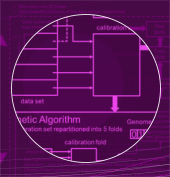
Measurement of partial expiratory flow-volume curves has become an important technique in diagnosing lung disease, particularly in children and in the elderly. The objective of this study was to investigate the feasibility of predicting abnormal spirometry using the partial flow-volume curve generated during a voluntary cough. Here, abnormal spirometry is defined as less than the lower limit of normal (LLN) predicted by standard reference equations [1]. Cough airflow signals of 107 subjects (56 male, 51 female) were previously collected [2] from patients performing spirometry in a pulmonary function clinic. A variety of features were extracted from the airflow signal. A support vector machine (SVM) classifier was developed to predict abnormal spirometry. Airflow signal features and SVM parameters were selected using a genetic algorithm. The ability of the classifier to distinguish between normal and abnormal spirometry based on cough flow was evaluated by comparing the classifiers decisions with the LLN for the given subject’s spirometry, including forced expiratory volume in 1 s (FEV1), forced vital capacity (FVC), and their ratio (FEV1/FVC%). Findings indicated that it was possible to classify patients whose spirometry results were less than the LLN with an overall accuracy of 76% for FEV1, 65% for FVC, and 76% for the ratio FEV1/FVC%. Accuracies were determined by repeated double cross-validation [3]. This study demonstrates the potential of using airflow measured during voluntary coughing to identify test subjects with abnormal spirometry.

